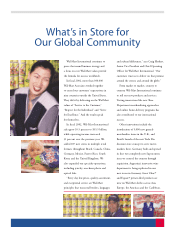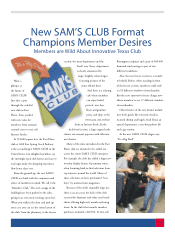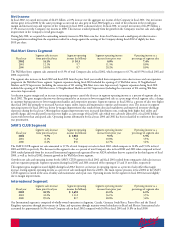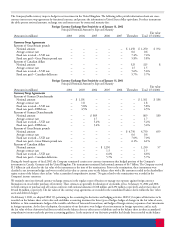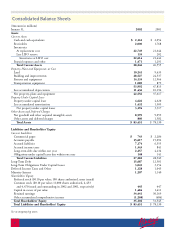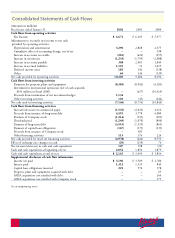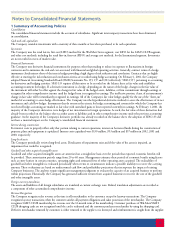Walmart 2002 Annual Report Download - page 20
Download and view the complete annual report
Please find page 20 of the 2002 Walmart annual report below. You can navigate through the pages in the report by either clicking on the pages listed below, or by using the keyword search tool below to find specific information within the annual report.
18
The fiscal 2002 increase in international sales and operating income primarily resulted from both improved operating results and our international
expansion program. In fiscal 2002, the International segment opened 107 units. Partially offsetting the impact of the expansion program, changes
in foreign currency exchange rates negatively affected the translation of International segment sales into U.S. dollars by an aggregate of $1.1 billion in
fiscal 2002. The largest portion of the increase in the International segment’s net sales in fiscal 2001 primarily resulted from the International segment’s
expansion that consisted of the opening of 77 units. Also affecting the comparison between fiscal 2002 and 2001 and fiscal 2000 was the acquisition of
the ASDA Group PLC, which consisted of 229 stores when its acquisition was completed during the third quarter of fiscal 2000. Sales included in the
Company’s consolidated income statement for ASDA during fiscal 2002, 2001 and 2000 were $15.3 billion, $14.5 billion and $7.2 billion, respectively.
The positive effects of the expansion program on the International segment’s net sales in fiscal 2001 were partially offset by changes in foreign currency
exchange rates which negatively affected the translation of International segment sales into U.S. dollars by $1.3 billion in fiscal 2001.
The fiscal 2002 increase in segment operating profit as a percentage of segment sales resulted from an improvement in gross margin and a reduction
in operating expenses as a percentage of segment sales in fiscal 2002. The decrease in the International segment’s operating income as a percentage
of segment sales in fiscal 2001 resulted primarily from the continued negative impact of store remodeling costs, costs related to the start-up of a new
distribution system, excess inventory and transition related expenses in the Company’s Germany units. Partially offsetting these negative effects were
operating profit increases in Mexico, Canada and the United Kingdom in fiscal 2001 compared with fiscal 2000.
Our financial results from our foreign operations could be affected by factors such as changes in foreign currency exchange rates or weak economic
conditions in the foreign markets in which the Company does business. The Company minimizes exposure to the risk of devaluation of foreign
currencies by operating in local currencies and through buying forward currency contracts, where feasible, for certain known funding requirements.
The economic environment in Argentina has deteriorated during the last fiscal year, including the devaluation of the Argentine peso. We will continue
to monitor the economic situation but do not believe the Company’s investment in operations in Argentina, which is not significant, has been impaired.
In fiscal 2002, the foreign currency translation adjustment changed from the fiscal 2001 level by $472 million to $2.2 billion in fiscal 2002 primarily
due to a strengthening in the United States dollar against the local currencies of the countries in which the company has operations with the exception
of Mexico where the peso strengthened against the dollar. In fiscal 2001, the foreign currency translation adjustment changed from the fiscal 2000 level
by $1.1 billion, primarily due to the dollar strengthening against the British pound and the German mark.
Other
Segment sales increase Segment operating Segment operating income Operating income as a
Fiscal year from prior fiscal year income (in billions) increase from prior year percentage of segment sales
2002 30.8% ($ 714) (147.9%) (5.2%)
2001 20.3% (288) (9.5%) (2.7%)
2000 23.2% (263) 37.2% (3.0%)
Sales in the Other category comprise sales to third parties by the Company’s wholly-owned subsidiary McLane Company, Inc., a wholesale distributor.
McLane offers a wide variety of grocery and non-grocery products, which it sells to a variety of retailers including the Company’s Wal-Mart Stores and
SAM’S CLUB segments. McLane’s sales to other Wal-Mart companies are not included in the total sales of the Company.
McLane net sales to unaffiliated purchasers account for approximately 6.3% of total Company sales in fiscal 2002 compared with 5.5% in fiscal 2001
and 5.3% in fiscal 2000. The increase in McLane sales is the result of its acquisition of AmeriServe Food Distribution, Inc. (AmeriServe), which was
completed late in fiscal 2001.
Losses for the segment in each of the fiscal years presented primarily resulted from corporate overhead expenses including insurance costs, corporate
bonuses and various other expenses, which are partially offset by McLane operating income and the favorable impact of the LIFO adjustment of
$67 and $176 million in fiscal 2002 and 2001, respectively. The segment operating loss increased from fiscal 2001 due to an increase in insurance costs,
bonuses and a reduction in the LIFO benefit in comparison to the prior year.
Summary of Significant Accounting Policies
Management strives to report the financial results of the Company in a clear and understandable manner, even though in some cases accounting
and disclosure rules are complex and require technical terminology. We follow generally accepted accounting principles in the U.S. in preparing our
consolidated financial statements, which require us to make certain estimates and apply judgements that affect our financial position and results of
operations. Management continually reviews its accounting policies, how they are applied and how they are reported and disclosed in the financial
statements. Following is a summary of our more significant accounting policies and how they are applied in preparation of the financial statements.
Inventories
We use the retail last-in, first-out (LIFO) inventory accounting method for the Wal-Mart Stores segment, cost LIFO for the SAM’S CLUB segment and
other cost methods, including the retail first-in, first-out (FIFO) and average cost methods, for the International segment. Inventories are not recorded
in excess of market value. Historically, we have rarely experienced significant occurrences of obsolescence or slow moving inventory. However, future
changes in circumstances, such as changes in customer merchandise preference or unseasonable weather patterns, could cause the Company’s inventory
to be exposed to obsolescence or slow moving merchandise.
Financial Instruments
We use derivative financial instruments for purposes other than trading to reduce our exposure to fluctuations in foreign currencies and to minimize
the risk and cost associated with financial and global operating activities. Generally, the contract terms of a hedge instrument closely mirror those of
the item being hedged providing a high degree of risk reduction and correlation. Contracts that are highly effective at meeting the risk reduction and
correlation criteria are recorded using hedge accounting. On February 1, 2001, we adopted Financial Accounting Standards Board (FASB) Statements
No. 133, 137 and 138 (collectively “SFAS 133”) pertaining to the accounting for derivatives and hedging activities. SFAS 133 requires all derivatives,
which are financial instruments used by the Company to protect (hedge) itself from certain risks, to be recorded on the balance sheet at fair value and
establishes accounting treatment for hedges. If a derivative instrument is a hedge, depending on the nature of the hedge, changes in the fair value of the
instrument will either be offset against the change in fair value of the hedged assets, liabilities, or firm commitment through earnings or recognized in


